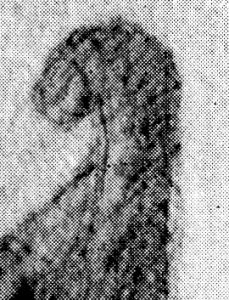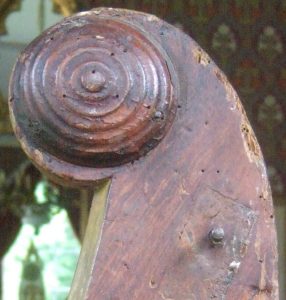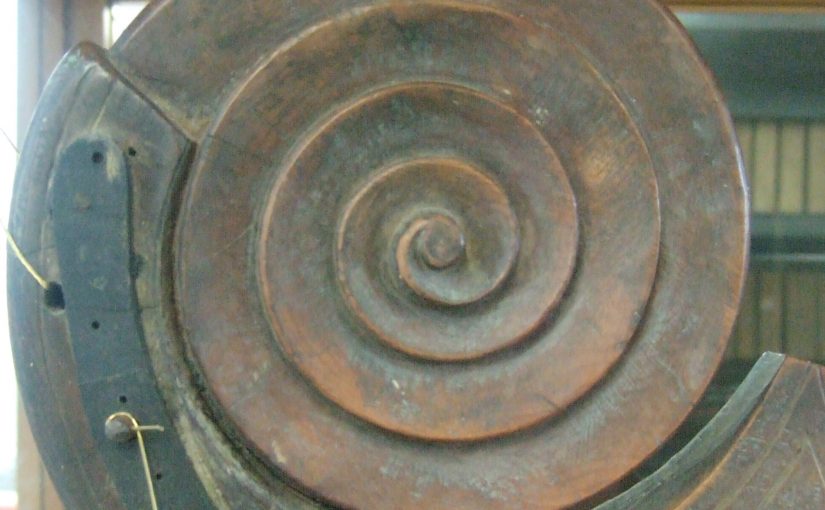A discussion about the provenance of the Rose Mooney or Carolan harp which is owned by the National Museum of Ireland, prompted some thoughts about the decorative finial on the tops of the forepillars of the old Irish harps. I thought it might be interesting to line them all up to see if there were patterns or groups.
I will count 13 harps dating from c.1650 to c.1750, representing the indigenous Irish harp making tradition in its final and most developed form. I also include a couple of harps now lost, and a few portaits of 18th century harpers with their instruments.
I have mirror-reversed some of these images so that all of the pictures show the scroll as if viewed from the right side of the harp.
Harps with true spiral scrolls
the Hollybrook harp

Deep wide carved scroll turned backwards (mirrored)
the O’Ffogarty harp

Huge deep tight scroll, turned backwards
the Fitzgerald or Kildare harp (traditionally dated 1672)

shallow tight scroll turned backwards. There is also an animal head facing upwards / backwards, but I think this is secondary to the scroll.
The portraits of Arthur O’Neill show a harp with a turned-back spiral scroll

(mirrored)
Harps with unclear or damaged scrolls
The portrait by Conn O’Donnell, of a harper (sometimes claimed to be Arthur O’Neill or Cormac Ó Ceallaigh). His harp may have a scroll turned back, but it is almost impossible to say. This portrait is in very poor condition and I have not seen a good reproduction of it.
The pencil sketch of a harper (sometimes claimed to be Charles Byrne holding the Mullaghmast harp) in Bunting’s papers seems to show a turned back scroll, only shown in outline.

The Mulagh or Mullaghmast harp
scroll, turned back, completely broken off.
The V&A harp

scroll, turned back, mostly lost
Harps with non-spiralling scrolls
the Rose Mooney or Carolan harp

(mirrored)
Deep wide concentric circles
the Malahide 1 or Kearney 1 harp

(mirrored)
Applied concentric boss turned back
the Clonalis or Carolan harp

flat disk, turned back. (mirror-image)
Harps with figural finials
The Downhill harp (made by Cormac O’Kelly, dated by inscription 1702)

Animal head facing forward, turned downwards
Captain Arthur Magenis’s harp, made by Cormac O’Kelly in 1711 (now lost), had a similar animal head facing forward, turned downwards.
the Sirr or O’Neill harp

(mirrored)
Bird’s head turned back
The Bunworth harp (made by John Kelly, and dated by inscription 1734)

(mirrored)
Human head facing forward
A harp belonging to Jonathan Hehir of Limerick, inscribed “Made by John Kelly in 1726”

(mirrored)
Human figure facing forwards
Harps without finials
The Otway harp is an archaic “low-headed form” without a finial. Some people suggest it is older than the other harps discussed here, though it is dated by inscription to 1707 and signed by Cormack O’Kelly.
The O’Neill harp

has no finial; however it is possible that there was originally one which has been cut away.
The portrait of Denis O’Hampsey shows a harp without a finial; I think that this is the Downhill harp with its animal head finial broken away before being later repaired. I don’t count this in the conclusion below.
Conclusion
Listed above are 17 examples. Of these, 10 of them (59%) have some kind of scroll (four true scrolls, two concentric non-spiralling scrolls, one plain disc scroll, three damaged or unclear scrolls).
Five of them (29%) have figural finials, three animal and two human.
Two of them (12%) have no finial.


I like to think that the animal/lion/wolfhound on top of the Kildare harp is a display figure. It looks beautiful when the harp is laid on its back, for storage and display. It might be a guardian for the pillar containing the coat of arms.
As for the scroll – I think the curious thing about it is the face of the monkey/weird thing on the outside of the scroll. It’s not that visible from over the harp, but I assume (from the position and all) it’s perfectly visible to the player, looking down on them when they’re playing. Probably judging their tuning. Or their choice of ornaments!
Looks like the Kildare harp is the only one where the scroll is embellished with other decoration.
We could add Malahide / Kearney 2, which has a flat circular scroll with an applied flower on the left side… not even sure how to categorise this one! And I don’t have a good photo of it.
I viewed the portrait of Arthur O’Neill by Conn O’Donnell dated 1804. The harp clearly has a round scroll turned back, though I could see no details within the scroll as to whether it was a spiral or a plain disk. There was a hint of a second scroll turned back at the top of the joint between pillar and neck, with a strak of paint suggesting a spiral scroll.